Population Abundances, Tidal Movement, Burrowing Ability and Oxygen Uptake of Emerita analoga (Stimpson) (Crustacea, Anomura) on a Sandy Beach of South-Central Chile
Abstract
Abstract. Field sampling and other experiments were carried out during February 2001 to determine whether different morphodynamic characteristics occurring within an intermediate sandy beach of southern Chile (ca. 39°S) convey differences in population abundance, tidal movement, burrowing ability and oxygen uptake of the anomuran crab Emerita analoga (Stimpson, 1857). Crabs were collected along transects extended between the lowest swash levels and the retention zone above the effluent line of the south and north end of the beach. Burrowing times of nearly 70 crabs collected at each study site were measured in saturated sands collected from the lowest swash level of each site. Oxygen uptake of crabs was measured in incubation glass bottles. The intertidal zone of the north end of the beach was wider (56 m) and flatter (1/14) than that of the south end (45 m and 1/9, respectively). In general, the swash zone of the north end was significantly wider than the south end throughout the sampling period. The frequency of swashes and number of swash crossings above the effluent line, plus up-wash speed, were usually higher at the steeper south end of the beach. The mean population abundance of E. analoga per linear metre of beach was significantly higher at the north end, whereas density per square metre was significantly higher at the south end. No differences were found in biomass figures. Although the highest abundance of crabs at the north end was usually observed at the lowest swash levels, similar population abundances occurred along all the tidal levels sampled at the south end. Burrowing times of crabs collected from both ends of the beach increased significantly with increasing carapace length and body mass. The mean burrowing time of crabs collected at the south end of the beach was shorter than that of those collected at the north end. Oxygen uptake of E. analoga was positively and exponentially correlated with the size of individuals collected from both ends of the beach. Results of ANCOVA showed no significant difference between the regression lines obtained for the oxygen uptake of crabs collected at both ends of the beach. It is concluded that physical features of each end of the beach seem not to differ enough to produce differences in oxygen uptake of E. analoga, or in the biomass, population structure and body size of crabs, within a single beach of south-central Chile.
Problem
The community structure of the macroinfauna of exposed sandy beaches has been usually correlated with morphodynamic beach types (e.g.McLachlan, 1990, 1996, 1998; Defeo et al., 1992; Jaramillo & McLachlan, 1993; McLachlan et al., 1993; Jaramillo, 1994; McLachlan & Jaramillo, 1995). That relationship resulted in a paradigmatic model, which states that species richness, abundance and biomass increase from reflective to dissipative conditions. It has thus been argued that swash features associated with beach types significantly affect macroinfauna community structure; this idea was first referred to as the swash control hypothesis (McLachlan, 1990) and, later, as the swash exclusion hypothesis (McLachlan et al., 1993). This hypothesis states that swash features become harsher from dissipative to reflective conditions. The extreme situation is found on fully reflective beaches, where only supralittoral species are found above the part of the beach exposed to the swash climate (McLachlan et al., 1993). One of the predictions of the hypothesis is that animals living in the harsher conditions, found towards the reflective end of the spectrum of beach types, should have a body size or behavioural adaptations allowing them to maintain themselves in their zone on beaches with those conditions.
Although the vast majority of the studies dealing with the relationship between sandy beach macroinfauna and morphodynamic beach types are related to the whole macroinfauna (e.g.Jaramillo et al., 1993; McLachlan et al., 1993, 1996, 1998), some studies have tested the predictions of the swash exclusion hypothesis in particular groups of invertebrates or single species. McLachlan et al. (1995) showed that shell shape and density of bivalves varied along a gradient of beach types: those inhabiting reflective sites were small, wedge-shaped and in high density compared with those from more dissipative beaches, which varied widely in those characteristics but tended to be larger and less dense. It was concluded that small size and high density were key adaptations to the harshest beaches, i.e. reflective systems with turbulent swash and coarse sand (McLachlan et al., 1995). Jaramillo et al. (2000) compared two populations of the anomuran crab E. analoga in two sandy beaches of south-central Chile and found higher population abundances, larger body sizes and a wider tidal migration at a dissipative site compared with a reflective one which had a narrower swash zone and higher frequencies of swashes and effluent line crossings. Comparisons among the abundance and life history characteristics of E. brasiliensis Schmitt, 1935 at two different beach types of the coast of Uruguay showed that, for most parameters, the results did not accord with the predictions of the swash exclusion hypothesis (Defeo et al., 2001). Finally, Dugan et al. (2000) found that the burrowing abilities of E. analoga and two other anomurans from the coast of California (Blepharipoda occidentalis and Lepidopa californica) support the prediction of the swash exclusion hypothesis: while the combined times of pre-burrowing and burrowing of E. analoga, a typical inhabitant of the swash zone, were shorter than the swash period, those of the other two species, which extend their distribution to the shallow subtidal zone, were similar to or longer than the swash period. This suggests that burrowing ability of E. analoga allows it to withstand the dynamics of the swash zone. The above-mentioned studies have analysed two predictions resulting from the swash exclusion hypothesis, i.e. the harsh swash climate found towards the reflective end of the morphodynamic beach spectrum would require organisms with high density and rapid burrowing ability to cope with short swash periods and high turbulence (McLachlan et al., 1995; Dugan et al., 2000).
Another prediction, not yet tested, is that the metabolic activity of invertebrates inhabiting the swash zone varies according to changes in swash climate. This prediction is supported by the fact that most of the typical invertebrates of the swash zone move up and down across the beach following the shift of the swash zone in different periods of the tidal cycle (e.g.Cubit, 1969; Tiffany, 1972; McLachlan et al., 1979; Fusaro, 1980; Shepherd et al., 1988). For a given species of macroinfauna, the metabolic cost of living on a reflective beach in a harsh swash climate could be significantly greater than on a beach with a more benign swash climate. This could be more apparent in tidal migrants or ‘swash-riders’ (Ellers, 1995).
The swash-rider E. analoga is one of the most common organisms of the Chilean sand beach macroinfauna; abundances as high as 72,000 indiv.·m−1 have been estimated (Jaramillo et al., 2001). In relation to biomass, this species is by far the main contributor, with values as high as 2000 g (ash-free dry weight)·m−1 (Jaramillo et al., 2001). Although this crab is found in the swash zone of all morphodynamic beach types, the highest abundances are found on intermediate beaches of this coast (Jaramillo et al., 2001).
As shown by Short (1996) and Short & Wright (1983), intermediate beaches are the most variable beaches with respect to along-shore topography. It follows that swash characteristics at those beaches will also be the most variable. The present study was designed to test the hypothesis that different morphodynamic characteristics occurring at a particular beach affect the population abundances, tidal migration, burrowing ability and metabolic activity of E. analoga. To test this hypothesis, we chose a modal intermediate beach of south-central Chile (ca. 39°S), characterised by the co-existence of areas with different slopes and, presumably, different swash characteristics. The use of a single site reduces the possibility of variation in metabolic rates caused by some of the factors that may vary geographically, such as differences in water temperature, food supply or genetics.
Material and Methods
1. Study area
The beach of Calfuco (39°52′ S, 73°13′ W) is about 1 km long. This is a microtidal beach, has maximum tidal ranges close to 1.5 m, and is fully exposed to the breaking waves of the Pacific Ocean. One of the study sites was at the steeper south end of the beach and the other was at a flatter area close to the north end (henceforth referred to as north end). This study was conducted during February 2001.
2. Swash and wave characteristics
At each site a transect of plastic poles (1.5 m long) was set up perpendicular to the shoreline. The plastic poles were erected at 2-m intervals along the transect of the southern end and at 3-m intervals along the transect at the north end. These differences in intervals are due to differences in the width of the intertidal zone, which is wider at the north end (see below). On 8 February 2001, the characteristics of the swash climate were measured continuously for 15 min at each of four tidal periods: flooding (10:30), 1 h after high tide (13:30), ebbing (16:30) and 1 h after low tide (19:30). These characteristics included the total number of swashes, the swash speed (estimated from the distance covered and the time elapsed between incoming swashes), the number of times any swash crossed the effluent line (i.e. the intersection of the groundwater table and the beach face) during the 15 min period, and the width of the swash zone (the distance between the lower and upper limit of the swashes). Concurrent with these measurements of swash characteristics, the height and period of waves at the breaker zone were also estimated. The wave height (n = 15) was estimated by measuring the height of breaking waves with graduated poles set against the horizon and adding that to the height difference between the location of the observer and the lowest point where the backwash met the next incoming swash bore. The wave period (measured with a stopwatch) was the time interval between breakers.
3. Beach characteristics

The values of settling velocity of sands were obtained from mean particle size according to Gibbs et al. (1971, Table 4). The morphology (i.e. the slope of the beach face) of each site was determined by Emery's profiling technique (Emery, 1961).
4. Across-shore distribution of E. analoga
Samples were collected at each site along three replicated transects, perpendicular to the shoreline, that were separated by 3 m. The lowest point of the transects was the lowest swash level, and the highest was beyond the point where crabs were found. The sampling zone therefore included the swash zone and part of the retention zone. The sampling was carried out during the spring low tide of 7 February 2001. Sampling stations were separated by 2 m at the south end and by 3 m at the north end. Samples were collected with a 10 cm diameter corer and sieved through a 1 mm mesh. Two cores were collected at each tidal level of each transect and pooled to make up each sample (0.02 m2). The number of crabs in each sample was counted and the crabs were measured with a calibrated series of sieves (Wenner et al., 1974) to determine the size frequency distribution.
5. Population structure of E. analoga
Crabs collected during the sampling aimed at examining the across-shore distribution of E. analoga (see above) were pooled into a single sample for each site, giving subsamples of about 500 individuals. These individuals were measured to the nearest 0.1 mm carapace length (CL) using callipers. The sex and reproductive condition of each crab were determined and recorded. Body size data were used to construct size-frequency distributions of crabs from each site. Analyses of population characteristics included female size at maturity (the smallest size at which 50% of the crabs were ovigerous), largest ovigerous crab (95th percentile size), smallest ovigerous crab (5th percentile size) and largest male crab (95th percentile size) (sensuDugan et al., 1991, 1994).
6. Tidal movement of E. analoga
Crabs were collected over a tidal cycle including four sampling periods: flooding, high tide, ebbing and low tide (8 February 2001). At each site, samples were collected at eight tidal levels along two replicated transects separated by 3 m and perpendicular to the shoreline. The tidal levels were: one in the lowest swash level, three in the swash zone, one at the effluent line and three in the retention zone above the effluent line. The distance between samples was constant at a site but varied with both time and site. Samples were collected with a 10 cm diameter corer and sieved through a 1 mm mesh. Two cores were collected at each tidal level of each transect and pooled to make up each sample (0.02 m2). Mean distributions for each sampling period were estimated through the following steps: (i) multiplication of the number of crabs collected at each level by the distance from that level to a dummy point (level 0); (ii) summation of all these values, and (iii) division of that sum by the total number of crabs collected during each sampling period. The confidence limits of 95% were estimated through the critical value of a ‘t’ distribution with n−1 degrees of freedom (n = number of levels sampled at each time) multiplied by the standard error.
7. Burrowing ability of E. analoga
The burrowing time of crabs collected at each study site was measured in sand collected from the lowest swash level of each site. The experiments were carried out on 9 February 2001 and consisted of measuring the burrowing time of 60–70 crabs that represented the full spectrum of body sizes collected at each site. The crabs were collected from the entire Emerita zone and experiments were run in the field, immediately after collection. The experiments were run in 5 l tubs (27 cm in diameter) with 6 cm of sand and a 4 cm water column. If necessary, the tubs were adjusted to create a level sediment surface. Individual crabs were timed from the initiation of burrowing (effective penetration of the carapace in the substrate) to the disappearance of the crab under the sediment surface. Crabs were removed from the sand immediately after burrowing and the sediments were reconsolidated by tapping the ends of the tub gently. Each experimental crab was measured (CL) to the nearest 0.1 mm and kept individually for later determination of dry mass [g]. The burrowing velocity was calculated as the ratio crab size [mm] to burrowing time [s]. The seawater temperature during the burrowing trials varied between 14.5 and 15.5 °C and the water salinity was 34. Linear regressions of burrowing time versus CL, and body mass were calculated and compared using ANCOVA with CL and body masses as covariates (Sokal & Rohlf, 1995).
8. Oxygen uptake of E. analoga
We used oxygen uptake as a measure of the metabolic activity of the crabs. The oxygen uptake was measured in incubation glass bottles (Karlsruhe bottles WTW, 315 ml) to estimate the respiration rate of E. analoga. Crabs were collected from the entire Emerita zone and experiments were run in the field, immediately after collection (10 February 2001). The crabs were graded according to the following body size categories: juveniles (CL = 5–7 mm), males (CL = 12–14 mm), non-ovigerous females (CL = 16–20 mm), medium-sized ovigerous females (CL = 18–20 mm) and large ovigerous females (CL = 25–27 mm). Six replicated incubation bottles filled with seawater from the surf zone were used for each of these categories. The number of crabs used for each category was as follows: 16 juveniles, 12 males, two non-ovigerous females, two medium-sized ovigerous females and two large ovigerous females. Each bottle had about 100 ml of native sand to allow burrowing and to prevent the crabs from swimming while the oxygen consumption was being measured. The oxygen uptake was also measured in two bottles filled only with seawater and 100 ml of native sand; these measurements were used as controls, i.e. for correcting the oxygen consumption by microorganisms included in the sediment or in the seawater. The experimental bottles were stored in a black plastic box and buried for 45 min below the surface in the resurgence zone of each site to avoid high air temperature. The experimental time was long enough to obtain easily measurable oxygen decreases, which never exceeded 20% of the initial oxygen concentration. The initial and final oxygen concentrations in each bottle were measured with an Oximeter-Orion 842 with auto-stir sensor. Regressions for the oxygen uptake of individual crabs [μmol O2·h−1] and the weight of individual crabs [g] versus CL and body mass were used and compared using ANCOVA with CL and body mass as covariates (Sokal & Rohlf, 1995). Prior to the ANCOVA, all data were transformed to natural logarithms to normalise the data.
Results
1. Sites and swash characteristics
The intertidal zone of the north end of the beach was wider (56 m) and flatter (1/14) than that of the south end (45 m and 1/9, respectively) (Fig. 1a). The particle size of sand from both ends corresponded to medium sands (250–500 μm; Folk, 1980); those of the south end were somewhat coarser than those of the north end (Fig. 1b).
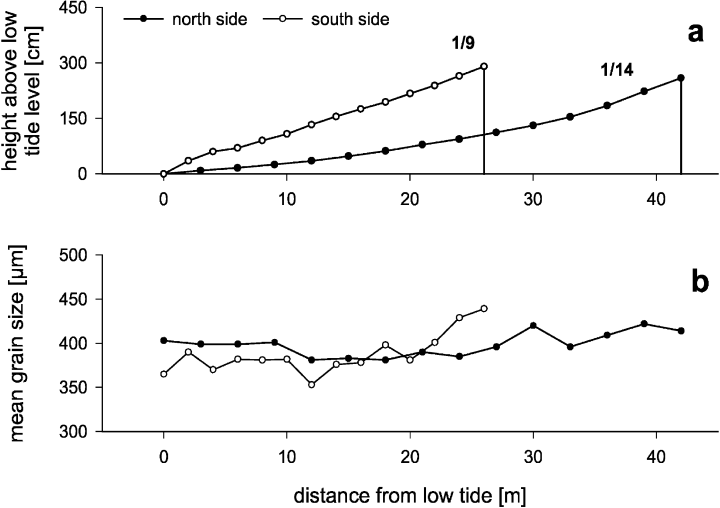
a: Beach face slopes at the north and south ends of Calfuco Beach during the sampling day of 8 February 2001. b: Across-shore variability in mean grain size of sands at both ends.
In general, the swash zone of the north end was significantly wider (P < 0.05) throughout the sampling period (Fig. 2a). Whereas the width of the swash on the north end tended to increase at low tide, that of the south end remained fairly constant. The frequency of swashes, the number of crossings of the effluent line in a 15 min period, and the up-wash speed were usually higher at the steeper south end of the beach (Fig. 2b–d). Waves were of comparable or greater height at the south end (Fig. 2e), and there were almost no differences in wave periods (Fig. 2f).
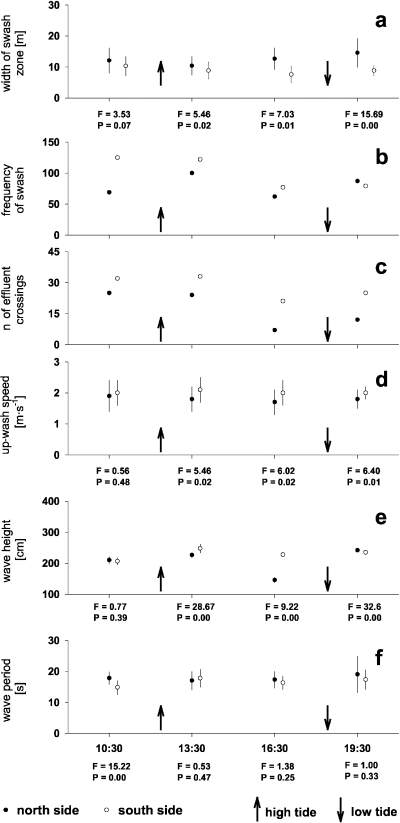
Swash and wave characteristics measured at the north and south ends of the beach over a 15 min period at each of four tidal periods: flooding (10:30), 1 h after high tide (13:30), ebbing (16:30) and 1 h after low tide (19:30). a: Mean width of the swash zone ± standard deviation; b: frequency (number) of swashes in 15 min; c: number of swash crossings above the effluent line in a 15 min period; d: mean up-wash speed ± standard deviation; e: mean height of breaking waves ± standard deviation; f: mean of wave period ± standard deviation. Values of F and P resulting from ANOVA are also given. Observed times of low tide and high tide were 12:30 and 18:30.
2. Abundance and biomass of E. analoga
Data collected during the sampling to analyse the across-shore distribution of E. analoga (7 February) showed that the mean population abundances per linear metre of beach were significantly higher at the north end, whereas densities (per square metre) were significantly higher at the south end (Table 1). The effect of this was that the biomass per linear metre of beach and per square metre did not differ significantly between the two ends (Table 1).
| population abundance | biomass (ash-free dry weight) | |||
|---|---|---|---|---|
| [indiv.·m−1] | [indiv.·m−2] | [g·m−1] | [g·m−2] | |
| north side | 243,000 (20,043) | 5746 (526) | 18,375 (6,585) | 438 (157) |
| south side | 198,978 (14,152) | 7731 (654) | 10,559 (1,774) | 377 (63) |
| t | 3.06 | −4.09 | 1.91 | 0.62 |
| P | 0.04 | 0.02 | 0.13 | 0.57 |
- The values in parentheses are standard deviations (n = 3). The values of t statistics (Student's test) and P values are also given.
3. Population structure of E. analoga
Polymodal population structures were observed at both ends of the beach (Fig. 3). Both structures were primarily (close to 85% of the whole population) represented by crabs having CL shorter than 12 mm. Males outnumbered females at both ends; the male:female ratio was 2.4:1 and 1.6:1 at the north and south ends, respectively. The size of the 95th percentile of the male crabs was 11.0 and 10.3 mm at the north and south ends, respectively. For the same males, the size of the 5th percentile was 6.5 mm at both ends. The size of the 95th percentile for non-ovigerous females was 9.3 (north) and 11.9 mm (south), whereas the size of the 5th percentile was 6.1 mm at both ends. The larger mode of crabs was primarily represented by ovigerous females. For these females, the size of the 95th percentile was 25.4 and 26.6 mm at the north and south ends, respectively. Finally, the size of the 5th percentile of the ovigerous females was 16.7 (north) and 16.2 mm (south).

Size frequency distributions of Emerita analoga collected from the north and south ends of the beach.
4. Across-shore distribution and tidal movement of E. analoga
The across-shore distribution of density of individual crabs and total biomass of E. analoga is shown in Fig. 4. At the flatter north end of the beach, most of the population occurred at the lower swash levels; at the steeper south end, however, high population abundances were also found at the upper swash levels (i.e. close to the effluent line). At both ends, biomass values were higher at the lower swash levels (Fig. 4).
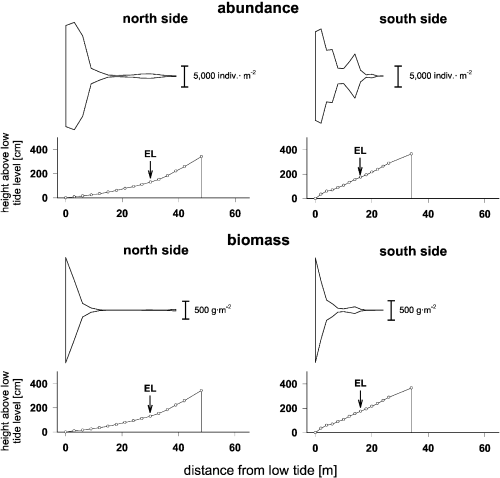
Across-shore distribution of Emerita analoga at the north and south ends of the beach during low tide on 7 February 2001. The mean abundance [indiv.·m−2] and mean biomass [g·m−2] of E. analoga for each sampling station are represented by the width of the kite diagrams for each end of the beach. EL: effluent line.
Figure 5a shows the variability with respect to position of the tidal cycle in the across-shore distribution of E. analoga at both ends of the beach. Although the highest crab abundance at the north end was usually observed at the lowest swash levels, similar population abundances occurred at all of the tidal levels sampled at the south end. The mean distribution of Emerita had a higher variability at the wider north end of the beach (Fig. 5b); thus, the mean distribution at that end varied from a maximum of 43 m during low tide to a minimum of 26 m from the level zero during high tide (a range of 17 m). On the contrary, the mean distribution at the narrower south end varied from a maximum of 30 m during low tide to a minimum of 21 m from the level zero during high tide (a range of 9 m).
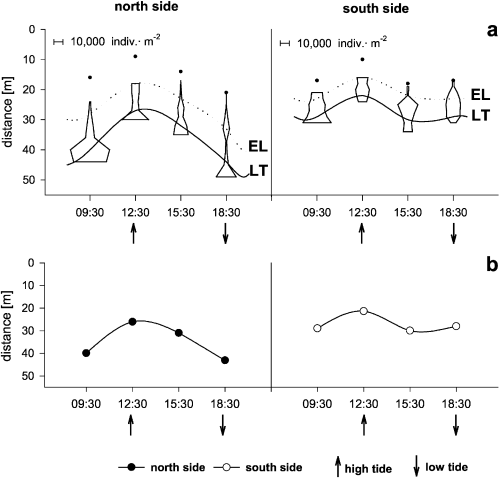
a: Tidal movement of Emerita analoga relative to a fixed position (0 m), to the effluent line (EL), and to the low tide (LT) or lowest swash level. Closed dots indicate the uppermost station sampled during each sampling period. The mean abundance [indiv.·m−2] of E. analoga for each sampling station is represented by the width of the kite diagram at each sampling time; b: mean distribution of crabs during each sampling period (see ‘Material and Methods’). Times of observed high tide and low tide are indicated by arrows. Sampling was carried out during 8 February 2001.
5. Burrowing ability of E. analoga
The body size ranges of crabs used in the burrowing trials were 7–30.8 (north) and 7–29.2 mm (south). These size ranges covered all those observed in the field but were recently recruited crabs. The burrowing time of crabs from both ends of the beach increased significantly with increasing CL and body mass (dry weight) (Fig. 6). Values of ‘north’ individuals ranged from 0.3 to 3.61 s in their native sediments (i.e. north end sands) and from 0.5 to 3.55 s in non-native sands (i.e. south end sands). Results of ANCOVA showed no significant differences between regression lines of burrowing times versus CL and body mass of crabs tested at both sediments (slopes and adjusted means for CL, respectively: F = 0.035 and P = 0.852; F = 0.829 and P = 0.364; slopes and adjusted means for body mass, respectively: F = 0.114 and P = 0.736; F = 0.410 and P = 0.523). The burrowing times of ‘south’ individuals ranged from 0.3 to 2.89 s in their native sediments (i.e. south end sands) and 0.3 to 2.81 s in non-native sands (i.e. north end sands). Results of ANCOVA showed no significant differences between regression lines of burrowing times versus CL and body mass of crabs tested in both sediments (slopes and adjusted means for CL, respectively: F = 1.290 and P = 0.258; F = 1.506 and P = 0.220; slopes and adjusted means for body mass, respectively: F = 0.851 and P = 0.358; F = 1.178 and P = 0.280).
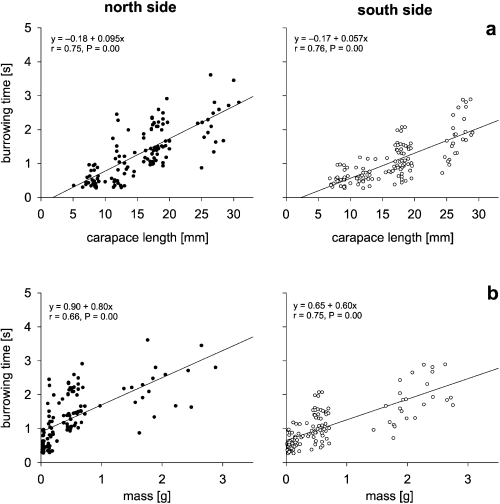
Burrowing time versus carapace length (a) and body mass (b) of Emerita analoga collected from the north and south ends of the beach.
The regression lines presented in Fig. 6 indicate that the burrowing times of crabs collected at the south end were lower than those collected at the north end, with both burrowing in their native sediment. Results of ANCOVA carried out to compare regression lines of burrowing times versus CL (Fig. 6a) and body mass (Fig. 6b) showed significant differences between slopes and means of those lines (slopes and adjusted means for CL, respectively: F = 5.310 and P = 0.022; F = 34.710 and P < 0.001; slopes and adjusted means for body mass, respectively: F = 4.500 and P = 0.035; F = 32.23 and P < 0.001). These differences in slopes show that the smallest and largest crabs at the south end had lower burrowing times than did those at the north end of the beach (Fig. 6).
The burrowing velocity of ‘north’ crabs decreased significantly with body size (burrowing velocity = −0.316 CL + 19.743, r = −0.268, P = 0.003). Thus, larger crabs excavated more slowly than smaller crabs. On the contrary, crabs collected from the south end showed no significant change in burrowing velocity with increasing body size (burrowing velocity = −0.066 CL + 19.442, r = −0.05, P = 0.230), i.e. crabs of different sizes had similar burrowing velocities. The mean burrowing velocity of ‘south’ crabs (18.3 mm·s−1) was significantly higher than that of ‘north’ crabs (14.7 mm·s−1) (results of ANOVA, F-ratio = 14.850, P < 0.001).
Burrowing ability was also analysed by comparing the burrowing times of crabs grouped in the following body size classes: juveniles (5–8 mm CL), males (9–15 mm CL), non-ovigerous females (14–20 mm CL), medium-sized ovigerous females (15–20 mm CL) and large ovigerous females (24–31 mm CL). With the exception of juveniles, the burrowing times of males, non-ovigerous females, medium-sized ovigerous females and large ovigerous females were significantly higher at the north end (Fig. 7).
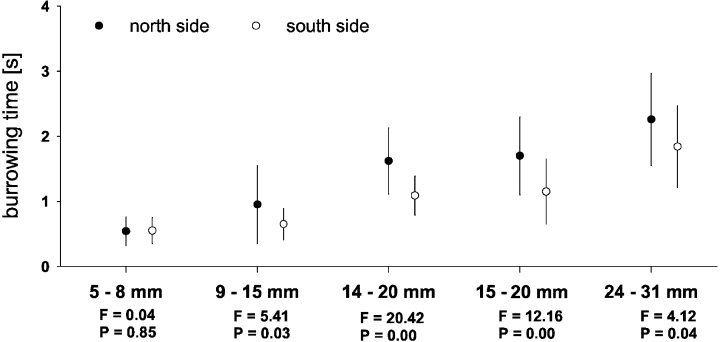
Burrowing time versus carapace length (CL) of five size groups of Emerita analoga collected from the north and south ends of the beach: juveniles, males, non-ovigerous females, medium-sized ovigerous females and large ovigerous females. Values of F and P resulting from ANOVA are also given.
6. Oxygen uptake of E. analoga
Oxygen consumption ranged from 3.52 to 99.5 μmol·h−1 (north end) and from 3.48 to 109.3 μmol·h−1 (south end). The values were always positively and exponentially correlated with individual size, with the slope of the curve being > 1 (Fig. 8a). In addition, oxygen consumption correlated positively and exponentially with individual biomass, with slope being < 1 (Fig. 8b). There was a negative correlation between oxygen consumption per unit of biomass and individual biomass (Fig. 8c); the oxygen consumption per gram of biomass of the smallest individuals was up to 57% higher than that measured in the largest individuals.
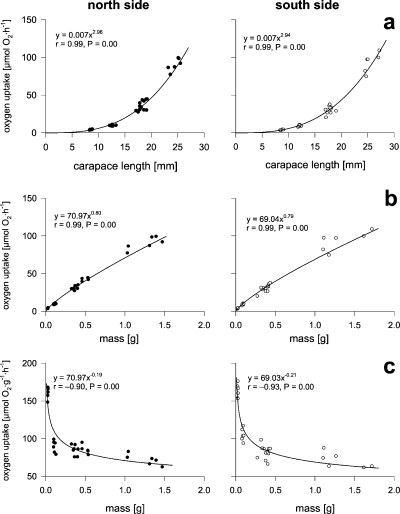
Oxygen uptake of crabs collected from the north and south end of the beach. a: Oxygen uptake of individual crabs versus carapace length (CL) of individual crabs; b: oxygen uptake of individual crabs versus body mass, and c: oxygen uptake per gram of individual crabs versus body mass.
Results of ANCOVA carried out to compare regression lines of oxygen uptake of individual crabs and weight of individual crabs versus carapace length and body mass showed no significant difference between the regression lines obtained for the oxygen consumption of crabs collected at both ends of the beach (slopes and adjusted means for the regression between oxygen uptake of individual crabs and CL, respectively: F = 0.047 and P = 0.829; F = 2.641 and P = 0.110; slopes and adjusted means for the regression between oxygen uptake of individual crabs and body mass, respectively: F = 0.386 and P = 0.537; F = 0.022 and P = 0.881; slopes and adjusted means for the regression between oxygen uptake per gram of individual crabs and body mass, respectively: F = 0.012 and P = 0.911; F = 0.038 and P = 0.846). The integration of the across-shore distribution of E. analoga and oxygen consumption of individuals allowed us to compare the total respiration rates of crabs collected from both ends of the beach by size. Statistical comparisons of estimates of oxygen uptakes of E. analoga per linear metre of beach and square metre yielded no significant differences (P > 0.05), even when oxygen consumption estimates per linear metre of beach were higher at the north end (Table 2). Figure 9 shows the across-shore distribution of oxygen uptake of E. analoga. Although most of the oxygen consumption at the north end was concentrated in the lowest levels of the swash zone, in the south end, part of this consumption occurred in the middle and upper levels of the swash zone.
| mol O2·m−1·h−1 | mol O2·m−2·h−1 | |
|---|---|---|
| north side | 1.21 (0.19) | 0.038 (0.008) |
| south side | 0.85 (0.11) | 0.038 (0.005) |
| t | 2.64 | −0.04 |
| P | 0.06 | 0.97 |
- Rates calculated upon estimations of population abundances (per linear metre of beach and per square metre). The values in parentheses are standard deviations (n = 3). The values of t statistics (Student's test) and P values are also given.
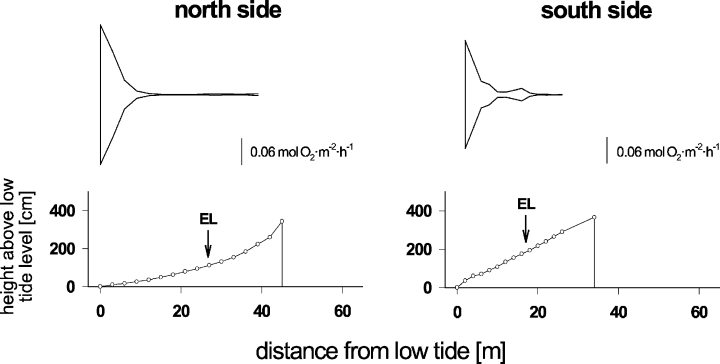
Across-shore distribution of respiration of Emerita analoga at both ends of Calfuco Beach. EL: effluent line.
Discussion
The physical data revealed that the two ends of Calfuco Beach studied here displayed clear differences in beach features (such as intertidal width and beach face slope) and swash characteristics (frequency of swashes, number of crossings beyond the effluent line and up-wash speed). The narrower and steeper intertidal zone of the south end (with higher frequency of swashes, effluent line crossings and up-wash speed) is close to the reflective end of the beach type spectrum, whereas the wider and flatter intertidal zone of the north end resembles more a high intermediate beach condition (cf. McArdle & McLachlan, 1991). Thus, intersite differences were large enough to provide an adequate framework to test our hypothesis.
The population abundance, across-shore distribution, intertidal migration and burrowing times of E. analoga differed between the crabs inhabiting the north and south ends of the beach. A narrower intertidal zone may well result in a higher density of crabs per square metre, as was found at the south end. In fact, E. analoga densities are usually higher in sandy beaches with features similar to those found at the south end of Calfuco (cf. Jaramillo & Lastra, 2001). Similarly, the more extended across-shore distribution of E. analoga at the south end, and the similar population abundances found all along the Emerita habitat during the tidal movement experiment might well be related to the narrower intertidal zone and thus probably to a more homogeneous environment. On the contrary, this narrower intertidal zone, being affected by a higher frequency of swashes and crossings above the effluent line (apart from a higher up-swash speed), might explain the shorter burrowing times of ‘south’ crabs. In other words, a shorter burrowing time can be viewed as a response to the harsher swash characteristics at the south versus the north end, where there are less frequent swashes and crossings above the effluent line. These last results differ from those reported by Jaramillo et al. (2001), who found no differences in burrowing times of crabs collected from a reflective and a dissipative beach in southern Chile (ca. 42°S). This shows the broad ranges of responses of this species distributed along the full spectrum of beach types and sediment sizes (Jaramillo & McLachlan, 1993; Dugan & Hubbard, 1996; Dugan et al., 2000; Jaramillo et al., 2000).
Population structures, body sizes and oxygen consumption of E. analoga were similar at both ends of the beach. Dillery & Knapp (1970) showed, on a sandy beach in California, that E. analoga is able to move along with the longshore currents, a situation that would probably mix the populations within a beach. That situation would explain the above-mentioned results for both ends of Calfuco, i.e. mixing masks differences in population structure, body size and oxygen consumption. However, the results provided by Dillery & Knapp (1970) show that, even if some individual crabs are able to move along with the longshore currents, the aggregations of Emerita studied in California seemed to maintain their positions fairly regularly, a pattern also found by Efford (1965) in another beach of California. Thus, alongshore movements of this anomuran crab are probably better described as passive movements instead of active migrations, as concluded by Díaz (1980) for E. talpoida on a sandy beach of North Carolina, USA. During the short time of our field study (several days), we did not observe any apparent disappearance or reappearance of crab aggregations at the north and south end of the beach. Thus, the absence of differences in population structure, body size and oxygen consumption are probably not related to possible crab mixing. At the same time, the observations on the persistence of crabs at both ends of Calfuco allow us to feel confident in the supposition that the studied crabs belonged to two discrete groups.
The metabolism of E. analoga, measured by their oxygen consumption rates, seems to be an adequate measure of its physiological activity. That activity had an allometric positive relationship with body size and a negative one with body mass. This allowed us to compare crabs subjected to different beach and swash characteristics. Even when metabolic activity, as measured by oxygen consumption, is an adequate indicator of physiological stress in marine invertebrates, such as for Donax trunculus (de la Huz et al., 2002), our results show no differences in oxygen consumption between north and south Calfuco Beach crabs; in other words, this measure of physiological activity was not affected by the differences in beach and swash features. The physical differences were probably not large enough to produce different responses in oxygen consumption. Thus, the similar physiological responses of E. analoga to different environmental conditions suggests that this crab has a wide acclimatization capability.
The negative allometric relationship between the biomass of E. analoga and its metabolism results in an energetic cost that is proportionally higher in the smaller versus larger individuals. Moreover, that allometric relationship shows two clearly differentiated stages: oxygen consumption of juveniles (biomass < 0.1–0.2 g) shows a strong negative slope, whereas that of the remainder of the population has a fairly smooth negative slope. The differences between the metabolic cost of juveniles and larger stages are consistent with the fact that most of the migrating crabs at both ends of the beach were represented by those stages, which is a similar relationship to that found in other marine invertebrates (Brown, 1983). Those allometric relationships may explain why crab populations with similar biomass but different size class distribution across the beach have different energetic requirements. This assertion is supported by the across-shore distribution of crabs and oxygen consumption. Although biomass values in the lowest level of the swash were similar at both ends of the beach (3000 g·m−2), oxygen consumption in the north end was 24% higher than in the south end: 0.300 and 0.228 mol O2, respectively (estimations of biomasses and oxygen consumptions from 4, 9). This is probably because more small individuals inhabited the lowest swash level of the north end.
Summary
Differences were found in the population abundances, across-shore distribution and burrowing times of the swash rider Emerita analoga within a modally intermediate beach of southern Chile. The narrower and steeper south end of the beach concentrates the crabs, resulting in higher densities [indiv.·m−2]. The higher frequency of swashes, higher number of swashes crossing the effluent line and higher up-wash speed at this end explain the shorter burrowing times of crabs. Despite these differences, the physical features do not seem to differ enough to produce differences in biomass, population structure, body size and oxygen uptake of E. analoga.
Acknowledgements
We wish to thank Jenifer Dugan and David Hubbard (University of California, Santa Barbara, CA, USA) for their helpful comments on an earlier manuscript. We acknowledge the financial support of CONICYT (Fondecyt Project no. 7000423 and 1000423) to EJ and ML during the fieldwork of this study. JL acknowledges travelling grants from Universidad de Vigo and Xunta de Galicia, España. GR acknowledges a travel grant and financial support for living expenses in Chile from Fundación Pro-Vigo, España. EJ was funded by Xunta de Galicia and Proyecto MECESUP AUS 01-11 (Chile) during the final stages of this study at Vigo.




